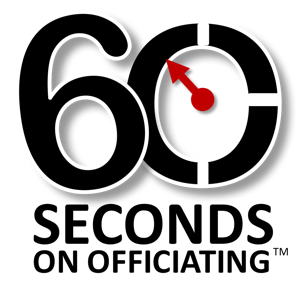Inbounding the New Season
In a hotly contested game after a made basket, B-1 is attempting to inbounds the ball while being pressured on the end line by A-1.
B-1 steps on the end line and passes the ball to B-2 who is out of bounds. B-2 subsequently bounces the ball while standing out of bounds?
Team A’s fans, and it’s head coach, loudly point out the position of B-1’s foot on the end line and scream for a penalty.
Others scream at B-2 for bouncing the ball on the throw-in.
Should the official rule any of these a violation?
The answer is NO, the official should not blow his/her whistle and rule these a violation.
A player inbounding the ball may step ON, but not OVER the end line or side line.
Let’s take a moment and expound on what an inbounder can legally do…During a designated spot throw-in, the player inbounding the ball must keep one foot ON or OVER the three-foot wide designated spot, but can move. If the inbounder does move outside of the three-foot area, it is to be ruled a spot violation (it is NOT a traveling violation). The mechanic is a raised open hand to stop the clock, and point to the designated spot.
There is no pivot foot required on a designated spot throw in, and the inbounder can jump up and return to the floor without having passed the ball.
A thrower with a designated spot may also move as far back as the layout of the court allows. Conversely, on a court with tight side lines and end lines, an official can ask a defender to move back a step (but no more than three feet.)
The thrower is legally permitted to bounce the ball before releasing it inbounds — as many times as the five-second count allows.
And remember, there is no designated spot after a made or awarded field goal or free throw. This means the team is permitted to run along the endline.
Also, if a timeout is called after a field goal or free throw, the the inbounding team is still permitted to “run” along the end line, and can still pass the ball to a teammate who is standing out of bounds along the same end line.
Officials who know their inbounding boundaries are bound to eliminate any problems that may crop up during these game situations!

It is mentioned that if a thrower in moves from the 3 foot designated spot, it is a traveling violation. I think the word NOT was inadvertently left out. Other than that GOOD STUFF! Merry Christmas
Thanks, “CLee”…the missing “NOT” has been added….
Thanks for pointing that out. When I explained that exact scenario to my cadets during class, they were amazed and looked at me like I had two heads. I also pointed out that you cannot travel out of bounds. The other night I was watching an NBA game where the inbounder did leave leave the 3 foot area. The official gave the traveling mechanic. I am just hoping that my cadets did not see that game. It certainly would have confused some of them.
Thank you so much. This helps me 100% l appreciate it. And keep them coming again thank you so much.
Nice job, Tim! We need to continue to educate coaches, players, fans and fellow officials. As a board Interpreter and trainer myself, it’s a never ending battle. Thank you!
It makes a difference where B2 is standing out of bounds. I’m assuming that you meant B2 was standing out of bounds along the end line. That information is critical to the review.
Nice scenario..good work Tim. This play could involve B-1 passing to B-2 out of bounds along end line and A-1 or A-2 subsequently reaching across and deflecting the legal out of bounds pass between teammate; which now adds another possibility to this particular play……a benign play that happens after each goal has the makings of quite a bit of rule knowledge if you are focused and ready…
Timely article. Just had a call two nights ago asking the same questions.
Please discuss the ability to dribble the ball within the 5 second time friend!
On the legal out of bounds pass where A1 or A2 reaches across the end line and touches the pass – that’s a technical foul on A1 or A2 – no delay of game warning is given (as it would if he merely reached across the line and didn’t touch the ball).
Now for a new wrinkle – what is the call if B1 makes a bounce pass to B2 while both are out of bounds?